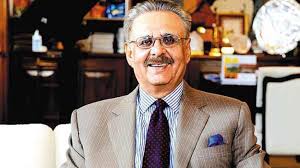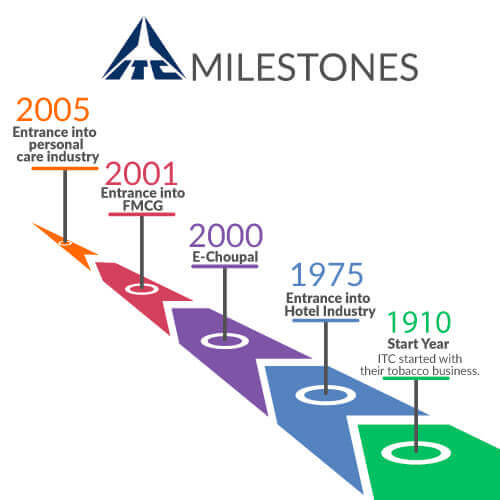ITC Case Study | Business Model (ITC Marketing Strategy)
2 Minute Summary
ITC Limited is an Indian multinational conglomerate company headquartered in Kolkata, West Bengal. ITC was started on 24 August 1910. The name of the company was the Imperial Tobacco Company.ITC business model was to sell cigarettes and tobacco And Expanded in Nepal in 1985. In 1974 they abbreviated their name to I.T.C Limited. ITC is one of the major players in the hotel sectors. The journey of their hotel industry started in 1975. And today they have 100+ hotel chain. Also, They started a couple of business under the ITC Group(Full Detail in Blog). ITC has more than 40 Lakhs farmers associated with them in their E-Choupal concept. The man behind ITC is YC Deveshwar joined in 1968. Also, He recognized with many awards. Also, there is much more detailed information in the Blog.
Have you ever wondered how the Indian Tobacco Company (ITC) became a leading FMCG Company in the market?
Yes, you got it right ITC was started as a tobacco company.
Here’s an ITC case study to cater to all your doubts!
Now, ITC stands out to be a key player in the FMCG industry.
Be it the sun feast in the biscuits & Ashirvaad aata in the flour category, all have a separate place in our hearts!
Let’s find out the journey of the tobacco company and their transformation into an FMCG company.
This ITC Case Study will help us in learning their business model, history, strategic management & much more.
What’s in it for me?
Let’s take an insight into what this ITC case study is all about
-ITC Analysis: How it became a huge success?
ABOUT THE TOP MANAGEMENT
Sivakumar Surampudi: Divisional Chief Executive of the Agri-Business Division

Sanjiv Puri: President of FMCG Businesses

Rajiv Tandon: CFO

Yogesh Deveshwar: CEO

Anand Nayak: Head of Human Resource Development

Initial Years
ITC Limited is an Indian multinational conglomerate company headquartered in Kolkata, West Bengal. ~Wikipedia
Let us start this ITC case study & see how everything started:
ITC was started on 24 August 1910 in Calcutta (now Kolkata).
The name of the company was the Imperial Tobacco Company.
ITC business model was to sell cigarettes and tobacco. They ran their business in a rented building.
ITC manufactured their products and hired services from outsiders for packaging & printing of their products.
Gradually the demand for their products started rising.
In 1925 they established their own factory in which they started their own printing and packaging of the products.
This can be said Strategic Backward Integration.
It means ITC started producing segments internally of its supply chain.
In 1926 they bought a building in Chowringhee (Now J.L. Road) for Rs.3, 10,000.
The building in Chowringhee is now called ‘Virginia House’- Headquarters of ITC.
In 1970 the name of the company changed from Imperial Tobacco Company to India Tobacco Company.
In 1974 they abbreviated their name to I.T.C Limited.
ITC is one of the major players in the hotel sectors. The journey of their hotel industry started in 1975.
In 1975 ITC acquired a hotel in Chennai which was rechristened ‘ITC- Welcome group Hotel Chola’ (now renamed My Fortune, Chennai).
Today, ITC has more than 100 hotel chains which are further divided into 4 sectors-

Luxury Collection

Welcome Hotels

Fortune Hotels

Welcome Heritage
ITC is also expanding globally. There are various projects of ITC that are running in countries like Sri Lanka, Dubai, etc.
ITC diversification strategy
Now, ITC was a big brand. In 1979 they diversified their business & started with the business of manufacturing paper boards.
They created a separate company for the paperboard business namely ‘Bhadrachalam Paperboards Ltd.’
They were performing well in India and it was now time to expand overseas.
In 1985 they started their cigarette and tobacco business in Nepal.
Later on, in 2002 it became the subsidiary of ITC Limited and was named as Surya Nepal Private Limited.
In 1990 ITC acquired Tribeni Tissues Limited (TTL). It was the same company which manufactured paper for their cigarette business.
Earlier they outsourced paper and now they started in house production of the same.
In 2002 ITC merged Bhadrachalam & TTL and made it a single group.
In 2004 they acquired another paperboard industry BIPCO. It was done to reduce their lead time due to the increased demand for their products.
strategy of itc enhanced its customer service.
They also entered into the business of exporting the garments.
AGRICULTURAL ENTRANCE OF ITC: E-Choupal
E-Choupal business model is of very great significance.
In 1990, ITC stepped into the agricultural sector. They had an advantage of excellent sourcing capacity.
They started with the concept of E-Choupal.
It enabled the farmers to sell their product with the help of internet.
It helped ITC to maintain an inventory with them which helped them in making one of the largest global exporters.
Today, ITC has more than 40 Lakhs farmers associated with them.
E-Choupal started from Madhya Pradesh where ITC partnered with soya bean farmers.
This initiative by ITC totally revolutionised the agricultural sector.
The farmers had easy access to mandi prices, good farming practices, and order placement for agricultural inputs, etc.
There are approx. 6100 e-Choupal that are currently functioning in more than 35000 villages in 10 states.
E-Choupal eliminated the middleman who exploited the farmers with their discriminatory practices.
ITC ENTRANCE INTO STATIONARY: ITC Classmate
Before, entering the stationary sector ITC made some changes in their names.
Indian Tobacco Company (I.T.C) was renamed to ITC.
The dots were removed i.e. the abbreviation was now the name of the company.
This was done to eliminate tobacco from their name as they wanted to enter into the stationary market.
In 2003 ITC started with Classmate.
ITC Classmate grew very rapidly. Many students started purchasing classmate’s notebooks and registers.
Today, the classmate is one of the premium brands in the notebooks.
In 2007-09 classmate came up with Practical Books, Drawing Books, Geometry Boxes, Pens, and pencils.
ITC ENTRANCE INTO CLOTHING: WILLS

In 2002, ITC entered into the clothing world also.
In India, they launched their trial run for the brand during the late ’90s.
Officially, ITC came up with their own brand in 2002. The name of the brand is Wills.
Today, Wills is a very premium brand with a variety of clothing.
ITC started wills which included only the sportswear. But gradually it became a very recognized brand & it offers a variety of clothing.
Wills also sponsors many fashion weeks.
Wills Lifestyle Fashion Week has gained recognition from buyers and retailers as the single largest B-2-B platform for the Fashion Design Industry.
OTHER BUSINESSES
ITC Business Model is not only limited to its cigarette & tobacco industry. There is much more to it:
-Branded Packaged Foods– In 2001 ITC launched their packaged food products. The packed food was launched in the name of Kitchen of India.
-Other foods– In 2002 ITC launched their candies like Candyman and Mentos. They also launched Ashirvaad aata in 2002.
In 2003 ITC also launched Sunfeast which marks a great presence in the FMCG sector.

In 2007 ITC came up with Bingo. We must have had Bingo mad angles once.
In 2010 ITC launched Yippee in competition with its rival Maggie by nestle.
In 2014 ITC came up with chewing gums and juices.
In 2015 ITC also launched their ghee in the name of Ashirvaad Ghee.
In 2016 they launched chocolates, coffee beans, and Master Chef Masalas range.
The master chef masala range were not ordinary spices. They were of premium quality with high essential oils content.
This was all done through E-Choupal. They used e-Choupal very strategically. They exported and manufactured the products from E-Choupal
In November 2017 ITC launched their vegetable stores in the name of farm line potatoes.
ITC started its food division in 2001. Today they have totally transformed this food division sector with their strategic diversification of business.
-Aggarbattis & Safety Matches-In 2002 ITC launched its Aggarbattis and safety matches. Mangaldeep Aggarbattis is of ITC.
-Personal Care Products– In 2005 ITC entered the personal care segment. You must have heard of Fiama Di Wills, Vivel Soaps, Supriya are all part of ITC.
In 2013 ITC came up with Engage Bodysprays
In 2015 ITC acquired the Savlon Company, an alternative of Dettol.
In 2017 they also acquired Charmis Face cream company.
MAN BEHIND THE ITC EMPIRE

By now, a question must have stuck on your mind that who is the person behind such success of ITC.
His name is YC Deveshwar. Mr Deveshwar joined ITC in 1968. He joined ITC straight out of his college.
YC Deveshwar was one of those rare examples who transformed the business of ITC, making it a huge success.
The endless list of rewards is evident in his hard work and mindful thinking-
-Was awarded Padma Bhushan
-Was awarded top India’s CEO by Forbes.
-Ranked 7th on world’s best CEO’s
-Served for the longest period (23 YEARS) as CEO in India for ITC
Mr Deveshwar who joined ITC in 1968, became the director in 1968.
Later, he became the CEO and Chairman in 1996.
In just sixteen years, he joined the Board of Directors.
These achievements show the role Mr Deveshwar played in nurturing ITC, making it a huge success.
Mr Deveshwar served Air India during 1991-94. This is the reason behind ITC’s slow growth during the above mentioned years.
ITC and YC Deveshwar were very synonymous, indeed he was a legend.
Sadly, Mr Deveshwar died on May 11, 2019. It was under his leadership that the company transformed from a cigarette major to an FMCG giant.
PM Modi also tweeted,” Shri YC Deveshwar made a strong contribution to Indian industry. His efforts helped ITC become a professionally-run Indian company with a global footprint. Saddened by his demise. My thoughts are with his family, friends and the ITC group in this hour of grief.”
GOLD FLAKE VS GODFREY PHILIPS ISSUE
In the absence of Mr YC Deveshwar, when he was serving for Air India during 1991-94, a new cigarette brand emerged with the name of Godfrey Philips.
It was trying to enter into the territory of Gold Flake which was an already established market.
The prices of Godfrey Philips were strategically kept low, to grab the market share of Gold Flake.
To stop this intruder, ITC launched a similar variant of Gold Flake which was cheaper than the original name.
They divided it into two categories Gold Flake Filter and Gold Flake King.
The former was cheaper than the latter one.
This not only helped ITC in diversifying their product line but also helped in retaining their market share.
ITC TIMELINE

| 1910 | ITCL(Imperial) established in Kolkata |
| 1925 | ITC’s Packaging and printing business was set |
| 1953 | Imperial converted into a public limited company |
| 1971 | It set up a marine product export division. |
| 1974 | The company changed its name to ITC Ltd. |
| 1975 | ILTC became a part of ITC |
| 1975 | Launched Hotel Business |
| 1986 | Established ITC Hotels as a separate division. |
| 1990 | ITC set up the Agri-Business Division |
| 1994 | Commissioned Mc. Kinsey to study their business |
| 2000 | e-Choupal initiative in Bhopal with Soya farmers |
| 2000 | ITC launched ‘Expressions’ |
| 2000 | ITC launched ‘Lifestyle’ |
| 2000 | ITC InfoTech |
| 2001 | ITC formed the food division |
| 2002 | ITC entered the safety match business |
| 2005 | ITC entered Essenza Di Wills |
ITC ANALYSIS (HOW ITC BECAME A HUGE SUCCESS)
Let us make a conclusion of this ITC case study.
According to me following are the factors that helped ITC in gaining such market capitalization & immense success.
A) Sourcing Capability– ITC has strong sourcing capabilities. With the help of various sources, ITC was able to extend its business in different sectors.
They entered into FMCG after establishing a strong base in the agricultural sector.
The wheat from the agricultural sector held in establishing a market for the Ashirvaad aata. Similarly, ITC used its various sources very effectively and efficiently.
B) Effective Brand Utilisation-After getting recognized in the agricultural & FMCG sector, ITC used its established brand name for entering into the stationary market.
They introduced classmate by ITC which helped them in grabbing a good market share.
Know how to do effective Business Branding.
C) Related Businesses-ITC had very interrelated businesses. This helped them in the in-house production of their raw materials.
For example, ITC used its paperboard business for the packaging of its various products. It reduced the costs & need for outsourcing.
D) Role of Management-Management is the heart and soul of a successful business. Having a leader like YC Deveshwar helped ITC in reaching heights.
E) Focus on Sustainability– ITC focuses on sustainability as its goal. Major projects of ITC are focusing on Sustainability.
They have targeted majorly those sectors which are sustainable in the long run, offering more growth.
F) Meeting Corporate Social Responsibility (CSR)– ITC focuses on fulfilling its social responsibility.
This aspect is very important in today’s scenario.
They started serving the society in Sarapaka, an economically backward area in Andhra Pradesh.
ITC contributed to the development in education, environmental protection & community development.
ITC HOTELS
FAQ’s
ITC business model was to sell cigarettes and tobacco. They ran their business in a rented building. ITC manufactured their products and hired services from outsiders for packaging & printing of their products.
strategic analysis of itc(How it become huge)
A) Sourcing Capability
B) Effective Brand Utilisation
C) Related Businesses
D) Role of Management
E) Focus on Sustainability
F) Meeting Corporate Social Responsibility (CSR)




nice sharing blog with too good information this blog.
Woah the following website can be superb everyone loves learning your content regularly.. digital marketing Keep on the wonderful paintings! You now know, many people are hunting close to because of this info, you could potentially help them to considerably.
Kindly update pie chart,
Ds group is mentioned above it.
“Mr Deveshwar who joined ITC in 1968, became the director in 1968.”
There is an error in this line.
website designer Hi awesome site! Man. Outstanding. Awesome. I’ll save your site plus make nourishes furthermore? I will be grateful to get a lot of valuable information and facts in the actual submit, we’d like grow a lot more tactics for this respect, appreciate expressing.
Sir I have had good learning with this ITC cass study, thank you so much Sir.
Woah this web site is fantastic i adore mastering your content regularly.. adobe web design Sustain the nice do the job! You already know, lots of people are usually shopping around due to this facts, you could potentially help them considerably.
Thank you for sharing excellent informations. Your web-site is so cool. I’m impressed by the details that you have on this blog. It reveals how nicely you perceive this subject. Bookmarked this website page, will come back for more articles. You, my pal, ROCK! I found simply the information I already searched everywhere and simply could not come across. What a great site.
I do agree with the many basics you’ve got shown your posting. They are pretty persuading and will certainly do the job. Continue to, this content are extremely quick for freshies.. cms website designing May well you please prolong these folks slightly out of next moment? Thanks for the publish.